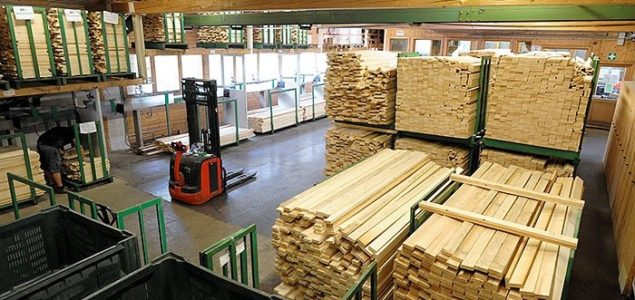In the context of globalized economics, the wood industry has become an important part of the global supply chain, contributing to the economic development of many countries. Among them, some countries have established their position on the international market as the leading wood export powers of the world. In this article, we will discuss the 20 largest wood exporting countries in the world. This not only reflects the current trade situation but also shows the trends and challenges that the global wood industry is facing.

Table of Contents
Overview of the Wood Industry
The wood industry plays a vital role in the global economy, not only by supplying raw materials for various sectors such as construction, furniture production, and paper but also by creating jobs and income for millions of people around the world.
According to a report from Mordor Intelligence, the current market value of sawn wood is about 751.77 billion USD. This value is forecasted to increase to 780 billion USD by 2028, with a compound annual growth rate (CAGR) of 0.74%.

The Asia-Pacific region dominates the global wood market due to its high market share. With a high rate of wood consumption, particularly in China, this country has become the world’s largest importer of sawn wood, driven by rapidly growing furniture market demand. Leading wood producers in the Asia-Pacific region include India, Malaysia, and Vietnam.
Moreover, North America is one of the fastest-growing regions in the world, with an expected annual growth rate until 2028. Latin America and the Middle East Africa, on the other hand, account for a low market share.
According to a report from Fact.MR, Europe leads in sawn wood production and is aggressively pursuing green building standards, choosing wood as a sustainable means in construction to reduce carbon emissions.
Top 20 Largest Wood Exporting Countries in the World
From the data provided, it’s clear that the demand for wood in the industrial sector is increasingly high. Below is a ranking of the TOP 20 largest wood exporting countries in the world that K-TIMBER has compiled over the years:
Canada
Canada is among the leading countries in wood exports, with an export volume of about 29.7 billion USD annually. With a forest area of about 347 million hectares, accounting for approximately 9% of the world’s total forests, it provides a rich and diverse source of wood resources. The United States, Western Europe, China, and Japan are the largest wood importing countries from Canada. The main wood products include sawn wood, paper, and wood pulp.

Germany
Although not a country with a vast forest resource like Canada or Russia, Germany still plays the role of the world’s second-largest wood exporter, with an annual export volume reaching 24.2 billion USD. China, Austria, the USA, and Poland are among the main wood importing markets from Germany.
United States
With an export volume of about 21.7 billion USD, the United States is also one of the world’s largest wood exporters. Main export products such as maple, oak, and birch wood are particularly favored by countries like China, Canada, Vietnam, and Mexico.

Sweden
Renowned for its sustainable and efficient wood industry, Sweden focuses primarily on exporting sawn wood, paper, and wood pulp to major markets in the USA, China, and the Middle East. With nearly 70% of Sweden covered by forests and an annual export volume of 16.8 billion USD, Sweden has established its position as one of the world’s leading wood exporting powerhouses.
China
China is a key player in the global wood market, not only because of its large demand for imported wood to meet the needs of its domestic manufacturing industry but also due to its role as a hub for exporting processed wood products. The annual wood export volume reaches 14.8 billion USD, with key products like plywood, sawn wood, and veneer focused on various markets including the USA, Japan, and the UK. Guangxi is the largest wood-producing province in China.

Finland
The next country on the list of the world’s largest wood exporters is Finland, with an annual wood export volume of about 14.3 billion USD. Finland primarily focuses on exporting sawn wood and wood pulp. Major wood importing markets include Germany, the USA, Sweden, and China.
Brazil
Brazil’s key products such as plywood, timber, furniture, pulp, paper, and sawn wood are strongly exported, with an annual export volume of about 11.2 billion USD. Much of the country is covered by forests, with eucalyptus and pine being the main types of wood.
Russia
Russia, with the largest forest area in the world, plays a significant role in the global wood industry. The country is renowned for exporting a large quantity of roundwood and processed wood products. However, following its invasion of Ukraine, Russia has gradually shifted its focus towards Middle Eastern and North African countries due to trade sanctions from the West. In 2021, Russia exported wood worth 10 billion USD, affirming its position in the international trade market.

Austria
Austria ranks ninth in the world in wood exports, with a total export value of 7.7 billion USD in 2021. This reflects Austria’s strong position in the global wood industry, especially given that Austria has one of the highest forest coverage rates in Europe and a developed wood market. The main importing countries include Germany, Italy, Switzerland, Poland, and France.
France
France, with a total export value reaching 6.9 billion USD in 2021. This country mainly exports sawn wood, veneer, plywood, joinery, and paper products to markets such as Spain, Italy, and the USA.
New Zealand
New Zealand is ranked as the eleventh-largest timber exporting country in the world, with its export volume reaching $4.8 billion in 2021. The forestry sector is a significant contributor to New Zealand’s economy, standing as the fourth largest export earner after dairy, meat and wool, and horticulture. The country’s forestry exports were projected to be close to $7 billion by 2023. Logs constitute the largest portion of these exports, but New Zealand also exports substantial quantities of sawn timber, pulp, paper products, panels, and chips.

Chile
Chile is one of the world’s leading wood exporting countries, with a total export volume reaching 4.5 billion USD. The country’s export destinations for wood include significant markets like the United States, China, Japan, Mexico, and South Korea, showcasing a broad geographic reach for its timber products.
Thailand
Thailand has shown significant growth in its wood exports, marking a notable increase in the first four months of 2023 to 36.4 billion Thai baht, a 5.31% increase compared to the same period in the previous year. In Thailand, rubberwood or imported wood is used as an alternative to the exploitation of hardwood due to the ban on deforestation.
Czech Republic
The Czech Republic is recognized as one of the important timber producers globally, ranking 14th among the largest timber exporting countries. In 2021, it exported timber worth $3 billion, exchanging timber with countries like China, Austria, Romania, and Slovakia, highlighting its significant role in the global timber market.

Portugal
Portugal has an export volume of about 2.9 billion USD each year, with eucalyptus wood being the most preferred in the country. This high output not only reflects the global demand for this type of wood but also demonstrates the country’s capability in forest management and sustainable development.
Malaysia
Malaysia is one of the world’s significant timber exporters, with its market staying vibrant thanks to the export of plywood, sawn wood, and furniture. In 2021, Malaysia’s timber exports were valued at $2.5 billion. The country’s exports are primarily directed to Japan, the US, Singapore, and India, showcasing a diverse market reach.
Latvia
Latvia is largely covered by forests, making it a potential global timber market. The country exports about $2.4 billion worth of wood products annually, mainly processed wood. Major importers are the UK, Germany, and Sweden.

Uruguay
Uruguay is known for its vast native forests, which produce a variety of valuable timber species, including eucalyptus, pine, and poplar. The Uruguayan timber industry is a significant contributor to the national economy, with exports worth approximately $2.3 billion in 2021.
India
India is known as one of the largest producers of tropical timber in the world, with annual exports estimated at around $2.05 billion. The United States, China, and Nepal are the main import markets for Indian wood. However, the Indian timber export industry is also facing challenges from unsustainable forestry practices and illegal logging.

Romania
Romania is another major wood exporter with a large stock of old-growth forests. However, illegal logging is threatening a significant portion of Romania’s forest area. The US, Italy, and China are the main import markets for Romanian wood, with an estimated annual export value of around $2.04 billion.
The wood export market plays an important role in the global economy. Despite facing challenges such as climate change and international competition, the market is expected to continue growing in the coming years. This article has hopefully provided you with an overview of the global wood export market and its potential for future development.










![[K-Timber] Blog Post](https://k-timbers.com/wp-content/uploads/2024/09/Ban-sao-cua-K-Timber-Blog-Post-Boder.png)
